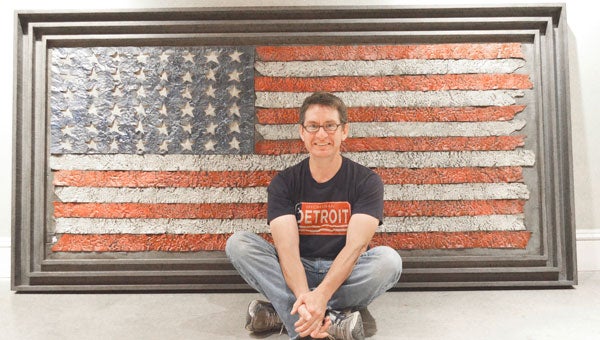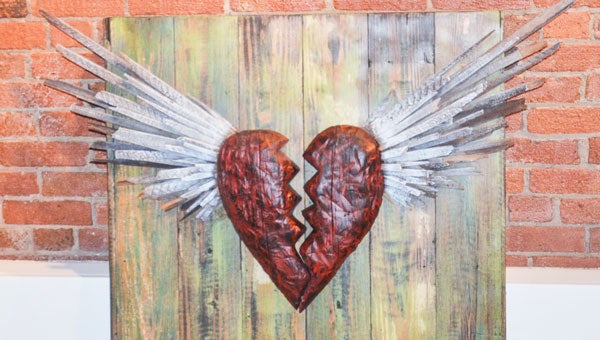‘WELL YOU SHOULD’: Artist’s challenge drives Beck to create
Published 3:00 am Saturday, May 21, 2016

Alabama artists Chris Beck and Lindy Bruggink will be honored with a reception from 6:30 until 8:30 p.m. Thursday at the Johnson Center for the Arts in downtown Troy. The reception will also include an art talk by the artists whose artwork is on exhibit at the art center. The public is invited.
Internationally acclaimed metal artist Charlie Lucas called Chris Beck out. “He saw inside my soul,” Beck said as he vigorously rubbed the goose bumps that claimed his arms at the remembrance of Lucas’ words.
“I was at an art show in Atlanta and Charlie Lucas was there,” Beck said. “I had always admired his work but I had never had the honor of seeing him. How he could take something rusty and seemingly useless and create something so incredibly wonderful amazed me. I was in awe of his talent.”
Beck has often wondered how he got the courage to approach Lucas.
“I told him how much I admired his work and how much I appreciated him as an artist,” Beck said. “I was talking too much and embarrassing myself and probably him, too. But he was polite and gracious.”
When Beck stopped “blubbering” long enough to catch his breath, Lucas asked, “So what do you do?”
Beck was stunned beyond words. When he finally could speak, he simply said, “Nothing.”
Lucas replied, “Well, you should.”
“That was so powerful,” Beck said. “Charlie Lucas saw inside my soul. His words, ‘Well, you should,’ lit a fire inside me. If he saw something in me, then I believed something was there.”
Beck is not sure what path he would have taken if he had not had that brief encounter or that divine appointment with Lucas. However, he is certain the direction he took was because of it.
“Something like that just doesn’t happen,” Beck said. “It was a divine appointment.”
From that moment forward, Beck knew that he should do something with the passion that burned inside him, the passion to create, the desire to make something ordinary into what it wanted to be.”
Beck’s introduction to “folk” art was rather casual. Lucas and the other “untrained” artists were doing something that he admired. They were using junk to create works of art, but it was art with a purpose.
“If you looked at Charlie Lucas’ metal sculptures, you might think he had taken junk and lumped it together and called it art,” Beck said. “But if you talked to him, each piece that made up his artwork was there for a purpose. It had meaning. It was a creation. It was art.”
At the time, Beck, a former Trojan, was working as a carpenter. So, he was surrounded by debris of all kinds — roofing and boards and things rusty and hard. In his mind’s eye, junk became more than junk. It became objects of art or for art.
One day, he found an old metal ironing board and was captivated by the shape and texture of the green metal. He viewed it with an artist’s eye.
He stood the ironing board up and admired it from one angle to another.
“I decided that it needed something on it,” he said. “I started thinking what would be on an ironing board. A shirt. A shirt would be on an ironing board.”

Alabama artists Chris Beck and Lindy Bruggink will be honored with a reception from 6:30 until 8:30 p.m. Thursday at the Johnson Center for the Arts in downtown Troy. The reception will also include an art talk by the artists whose artwork is on exhibit at the art center. The public is invited.
Beck had some welding experience so he cut a shirt out of rusty tin and placed in on the ironing board. The sculpture caught the interest of a visitor at an art show. He inquired about the piece.
“The gentleman said he would like to buy the shirt if I could cut it off the ironing board,” Beck said. “He offered to pay full price for just the shirt so I cut it off the ironing board and the man went home with a new shirt.”
The man who purchased the “shirt” sent Beck a photograph of the flat, rusty shirt hanging on the wall in his home.
“It was nothing but a rusty shirt, but it was art,” Beck said. “I started thinking what if the shirt had movement? What if there was a guy in there?”
That was the beginning of what, perhaps, Charlie Lucas saw inside Chris Beck.
Today, Beck is a noted metal artist. He creates beautiful things out of hard, rusty metal – soft and delicate things. With a hammer and an anvil, Beck creates.
“People often ask me what tools I use and I say a hammer and an anvil,” he said with a smile. “They ask again, ‘What tools?’ and I say a hammer and an anvil.”
Beck and the metal work together to make art.
“I don’t start out with an idea,” he said. “What I do is labor intensive. I hammer the metal, pound it, beat it until it’s what it wants to be.”
What “it wants to be” might be a lacy dress for a little girl or a Sunday suit for a little boy. It might be a flower or a flag. It might be an athletic shoe or an antler, or tin squares or a tiny butterfly.
But no matter what the metal wants to be, it’s the man with the hammer and the anvil who creates it.
Chris Beck creates because he can’t not create. And, well he should.

Alabama artists Chris Beck and Lindy Bruggink will be honored with a reception from 6:30 until 8:30 p.m. Thursday at the Johnson Center for the Arts in downtown Troy. The reception will also include an art talk by the artists whose artwork is on exhibit at the art center. The public is invited.



